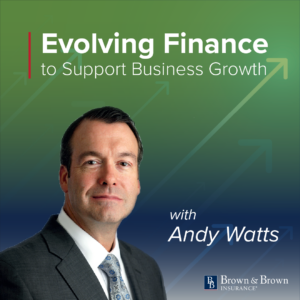Financial Outlook 2023: Prepare for the Unexpected
by Andy Watts, Executive Vice President & Chief Financial Officer at Brown & Brown Insurance
Volatility, uncertainty and unexpected turbulence have made the financial ride bumpy over the last two years, and in 2023 that jostling will more than likely continue. The road in front of financial professionals today is shrouded in heavy patches of fog, with the weather forecast projecting conditions to change regularly over the next six months.
With these conditions, it’s essential to expect the unexpected and be prepared by ensuring flexibility in your business’s strategic and capital allocation plans. While you may want to plan for the normal course of business, consider all the potential scenarios and don’t rule out any outcome. Then stress test the implications of each scenario on your business.
In turbulent times, it is critical to stay focused and nimble — be ready to pivot. Adjust your approach, where and when needed, to help your business leaders avoid emerging pitfalls in an unpredictable market. This also keeps you on the balls of your feet, so you are ready to capture opportunities as they become visible on the horizon. Opportunities to grow will be available to the prepared and proactive, who can move quickly to respond while the unprepared are still adjusting or unsure of what to do next.
As finance leaders and strategic business partners, we must deliver significant value to our organizations. During a down cycle is when you can shine: You can demonstrate how creatively using data, analytics and technology can help the organization look around corners or through the fog to see what others can’t see and then position your company to exceed revenue and profitability goals. Driving this type of value to the business will propel you to being a critical business partner and create significant shareholder value.
Stress testing recommendations or hypotheses with great data and analytics will help you succeed. Determine what data your organization needs to build driver-based budgets and forecasts, as these impact everything from inventory and capital expenditures to recruitment and retention. If the data you need doesn’t exist, lay out a roadmap to capture this data. Having some data is better than none when turbulent weather hits, as this is when you will be trying to determine the smoothest path forward.
When the scenarios and assessments are complete, discuss each in detail with your business leaders. For most operators, this discussion will unlock new ideas, opportunities and tactics for 2023. If you haven’t already, now is the time to prepare to improve the agility of your organization before the unexpected occurs.
6 focal points for 2023
As leaders within their organizations, financial professionals should consider the following six factors ahead of the upcoming year:
1. What does economic growth mean for your customers? Forecasting how your customers might react to economic changes in the coming months will help your organization prepare for the coming year. Economic turbulence will influence customer decisions all the way upstream to what, how, when and how much they buy or invest.
2. Interest rates will continue increasing. This will impact almost every company’s capital and borrowing costs, including debt and interest expenses. In one year, interest rates have doubled (from about 3% to 7%[1]), and they will likely go higher in 2023. Assess the impact of rising interest rates on your organization’s ability to make incremental investments and how the higher cost of capital will influence your returns. Now is a great time to review and adjust your organization’s expectations on return on investment (ROI) to reflect the changing rates.
3. Inflation has taken hold in all industries. In many cases, costs have been passed along to consumers. Passing the buck hasn’t ground the economy to a halt yet, but what happens if you’re a manufacturer who can’t pass additional costs on to the consumer? Adjustments or investments may be needed to run operations more efficiently and better manage costs in order to meet your profitability expectations in the current economic environment.
4. Advance recruitment and retention initiatives. As a financial leader, you should engage with human resources and other leadership stakeholders to determine what investments are necessary to sustain and grow your workforce. Employment demands will not diminish in 2023. Employees will seek salary increases to keep up with the rising costs of goods and services. But it’s not as simple as rewarding everyone. You need to ensure your best team players are compensated, recognized and rewarded. Determine how you will help incentivize and reward your top-performing talent in the year ahead, as these teammates will drive your success in 2023.
5. Understand each business unit and its profitability profile. If you don’t already assess each business on its journey, now is a good time to implement a 2×2 growth and profitability matrix. Chart each business unit in the matrix. Is the projected performance for 2023 the continuation of a trend or an outlier? If a continuation of a trend, what will you do differently to get a different outcome? This will help you analyze and determine sound recommendations for 2023 around growth and margin potential.
6. Perform an investment gut check. Ensure past investments are still delivering the expected value and that those you make in 2023 will deliver as well. These include capital investments, new business technology or new operational startups within your organization. Review parameters and assumptions for revenues, costs and ROI, as well as the sensitivity of the scenarios in place. If the expected gain doesn’t materialize, how will this impact your organization? That’s part of the profitability profile of each business unit, and the analysis should happen even in good economic conditions.
As a finance business partner within your organization, it is imperative for you to come to the table with multiple options backed by a total understanding of the drivers for the entire business. Business leaders will need insight, not spreadsheets of data they cannot decipher.
In a good economy, things can be easier, but in times like these, you must sharpen your pencil, know where the money is made and being spent, and determine if those areas are the best places to drive growth, profitability and value. Scenario planning, focusing on the drivers of the business and proper, solutions-oriented communication will help your organization make the strategic decisions to position you for success in 2023.
[1] Bankrate, “Latest mortgage news: Rates retreat even as Fed keeps pushing,” November 2, 2022.

Evolving Finance
to Support Business Growth
with Andy Watts, Executive Vice President & Chief Financial Officer at Brown & Brown Insurance
Subscribe to Andy’s Evolving Finance monthly newsletter and view this blog on LinkedIn here.








